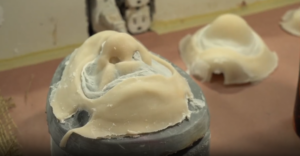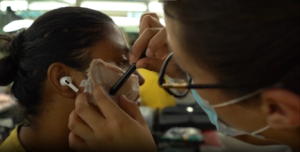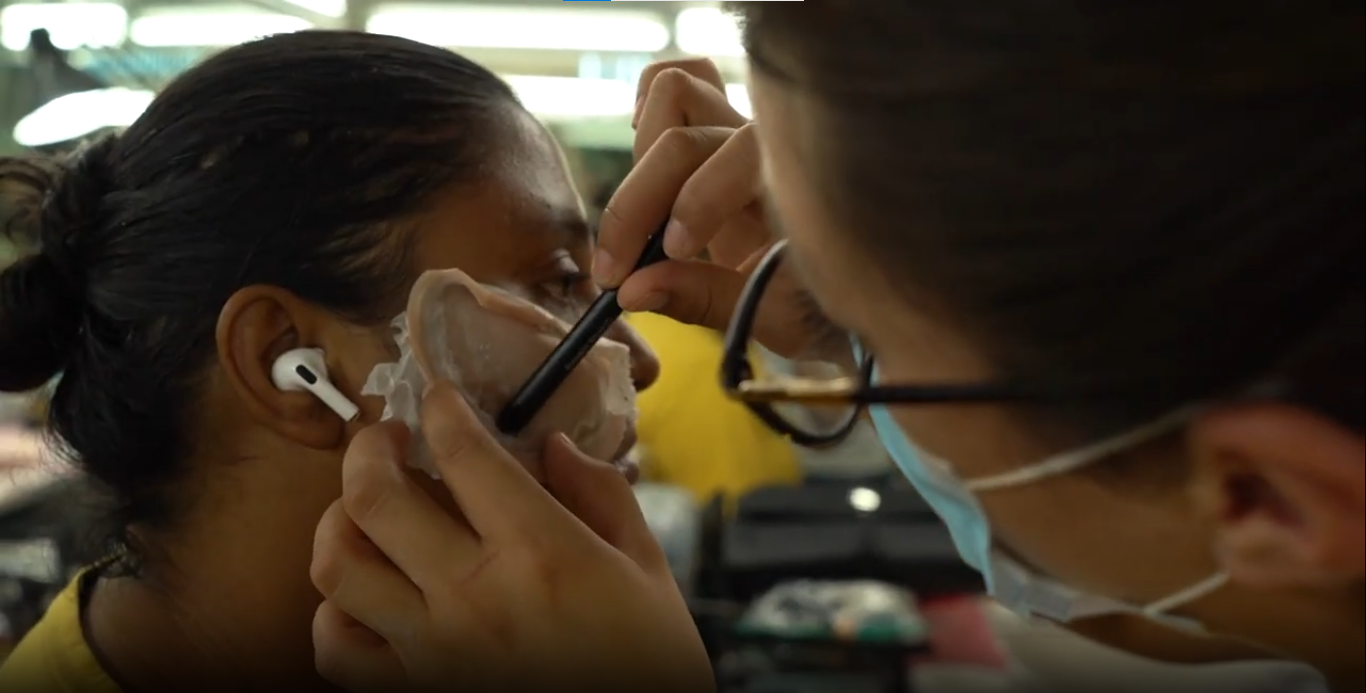Prosthetic masks transform storytelling in film, television and live performances. From mythical creatures to aged characters and grotesque monsters, prosthetics allow MUAs to stretch the limits of imagination and bring fantastical visions to life.
If you’re an aspiring SFX makeup artist, understanding the craft of prosthetic mask creation and application is essential. This guide will introduce you to the core materials, techniques, & career pathways and how training at a professional school can set you apart in the industry.

What Are Prosthetic Masks?
This is a specially designed facial appliance that changes the appearance of the wearer. It’s not just a costume piece; it’s a sculpted, hand-crafted extension of the actor’s face that integrates seamlessly with their expressions. These masks are used to create anything from realistic injuries to full-on creature features.
They come in various types:
- Foam latex prosthetic masks – Lightweight and breathable, ideal for extended wear.
- Silicone prosthetic masks – Known for their realistic texture and flexibility, often used for close-up shots. 3rd Degree Silicone is a favored choice for creating silicone masks that offer both flexibility and a lifelike appearance.
- Worth Noting: Each type of prosthetic material has its own strengths and ideal use cases, depending on the project’s budget, visual requirements and actor comfort.

How to Make a Prosthetic Mask?
Creating a prosthetic mask is a detailed process that combines life casting, sculpting, mold making, casting, painting and blending. Each step requires artistic skill and technical knowledge to bring characters to life realistically.
Here’s a simplified breakdown:
- Life Casting – The process starts by taking a mold of the actor’s face using alginate and plaster bandages. This creates a base on which the prosthetic will be sculpted.
- Sculpting the Design – Artists use clay to model the mask directly on the life cast, building the character’s features step by step. This step requires a strong understanding of anatomy and character design.
- Mold Making – A two-or three-part mold is created from the sculpted design. This mold is then used to produce the finished prosthetic.
- Casting the Prosthetic – Depending on the desired effect, artists use materials like foam latex, silicone, etc., to cast the mask. Each material requires different curing processes and handling.
- Painting and Detailing – Once cured, the prosthetic is painted using specialized pigments that work with the material’s surface. Fine details like veins, freckles, or texture are added here.
- Application and Blending – The final prosthetic is adhered to the actor’s face using medical-grade adhesives. Seamless blending with makeup ensures a natural and believable look.
See how our experienced MUAs create prosthetics:
General Query Answered:
How Do Facial Prosthetic Masks Help Individuals with Facial Differences Regain Confidence?
Prosthetic face masks can significantly enhance the emotional well-being of individuals with facial differences by restoring a sense of normalcy and helping them feel more confident in public and social settings. These prosthetics are carefully designed to match skin tone, texture and facial symmetry, allowing wearers to feel more comfortable in their appearance.
Beyond aesthetics, they can play a crucial role in improving mental health, reducing social anxiety and supporting a more positive self-image, especially after trauma, surgery, or congenital conditions.
How to Apply a Prosthetic Mask?
The application of a prosthetic mask is a step-by-step process that starts with skin preparation and adhesive selection. Edges are carefully blended to disappear into the skin, followed by precise color matching. Final effects like grime or sweat complete the transformation, making the prosthetic look lifelike.

- Surface Prep: Clean and prep the skin with a barrier spray or toner.
- Adhesive Application: Use pros-aide, medical adhesive, or silicone-based glues depending on the material.
- Edge Blending: Thin edges are carefully blended with the skin using solvents like acetone (for foam latex) or isopropyl myristate (for silicone).
- Color Matching: The prosthetic is painted to match the actor’s skin tone and lighting conditions on set.
- Final Details: Blood, sweat, dirt, or environmental effects are added to complete the look.
Well! Just reading the process won’t magically create prosthetic masks – Hands-on training is crucial to mastering these skills, especially since materials react differently under studio lights and on different skin types.
And the most important question that arises here is: who provides the best SFX makeup course?
For countless successful SFX makeup artists, the journey started at Cinema Makeup School – a proud part of Cinema Art College Corporation.
What Makes Cinema Makeup School Unique in the SFX Makeup Industry?
Becoming a skilled prosthetic makeup artist isn’t something you learn from YouTube alone. It requires guided instruction, feedback and real-world experience.
Students at Cinema Makeup School gain more than just technical knowledge, they immerse themselves in an industry-level environment.
Take a look at what our students get access to:
- Mentorship from industry veterans
- Access to professional-grade labs and tools
- Opportunities to work on live sets and studio projects
- Career guidance for breaking into film and TV
- Support through financial aid options
This kind of immersive experience is what truly prepares aspiring artists for competitive work in Hollywood and beyond.
Pro Advice: Practice With Self-Sculpts
Before taking on big projects, practice by sculpting prosthetics for your own face. You’ll learn a ton about facial anatomy, symmetry and what works in terms of comfort and fit. Additionally, it makes for great content on your portfolio or social media to show your range and creativity.
Related SFX Makeup Guides:
How 3D Printed Prosthetics Are Revolutionizing Movie Makeup?
How to Create Realistic Wounds and Scars with Prosthetics?
How to Create Creature Design Using Latex, Silicone & Prosthetics?
Prosthetic masks are a powerful tool in special effects makeup, offering limitless possibilities to transform actors into incredible characters. From lifelike injuries to fantastical creatures, mastering the process of creating and applying these masks is essential for any aspiring SFX makeup artist.
With dedication, practice and the right training, you can unlock your full potential and make your mark in film and TV. The skills you develop in prosthetic mask-making will open doors to exciting opportunities, allowing you to bring imagination to life on screen.


























































